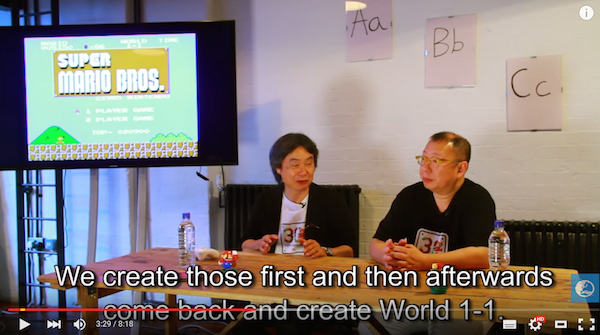
Ahead of the launch of Mario-themed level-building game Super Mario Maker, video game industry legend Shigeru Miyamoto sat down with veteran game designer Takashi Tezuka to take questions from journalists and show off its features.
Before leaping into the level creation proper, however, Miyamoto took a few minutes to talk about the creative process that is involved in building a Super Mario level, talking his audience through the steps he and his team took when creating the original Super Mario Bros., and explaining why World 1-1 of the game—for many their first ever brush with Mario on Nintendo’s 8-bit system—was built the way it is.
You’ve no doubt cleared this level countless times by now, but you may not have realised the hidden genius and careful planning that went into the positioning of every block, pipe, and pit of doom.
“Show, don’t tell,” my professor would tell me when critiquing my creative writing work back in my university days. “Let the reader discover without having everything explained to them.”
The same principle, it turns out, is applied to the best video game levels.
World 1-1 of Super Mario Bros. will be instantly recognisable to pretty much anyone who grew up in Japan or the western world in the 1980s and early 90s, and perhaps even to a few of those who experienced the game as a digital download for one of Nintendo’s more recent consoles. The original NES Super Mario Bros. did of course come with a printed instruction manual tucked in its box, but the majority of players—this writer included—were so eager to get started that they rarely even glanced at its pages before firing the game up. How, then, did game designer Miyamoto and his team explain the game’s rules to the player while ensuring that the learning process was both gradual and intuitive as well as being fun? You might be surprised:
Huh. Who knew?
▼They chose a mushroom as a power-up item because they figured the idea of a ‘suspicious mushroom’ would be understood all around the world…
▼ Coins hidden in blocks were an easy way to reinforce the action of jumping to hit them…
▼ New players will try to jump over the first power-up mushroom, mistaking it for another enemy. Thanks to the positioning of the blocks overhead, however, they’ll almost always touch the mushroom, grow bigger, and then realise it’s a power-up.
▼ A programmer once referred to the original design of a Goomba as a kuri (chestnut), giving rise to the Japanese name for the character, which has stuck until this day.
▼ Oh, and that seemingly random hole with nothing in it midway through the level…
▼ …was a subtle way of preparing the player for what was to come.
Remember, folks: show, don’t tell.
Good luck with your own level designing if you’re picking up Super Mario Maker at the end of the week! By all means leave your level codes in the comments section below so we can play them too!
Thanks to Eurogamer for putting this great video together.
Source & screenshots: YouTube/Eurogamer

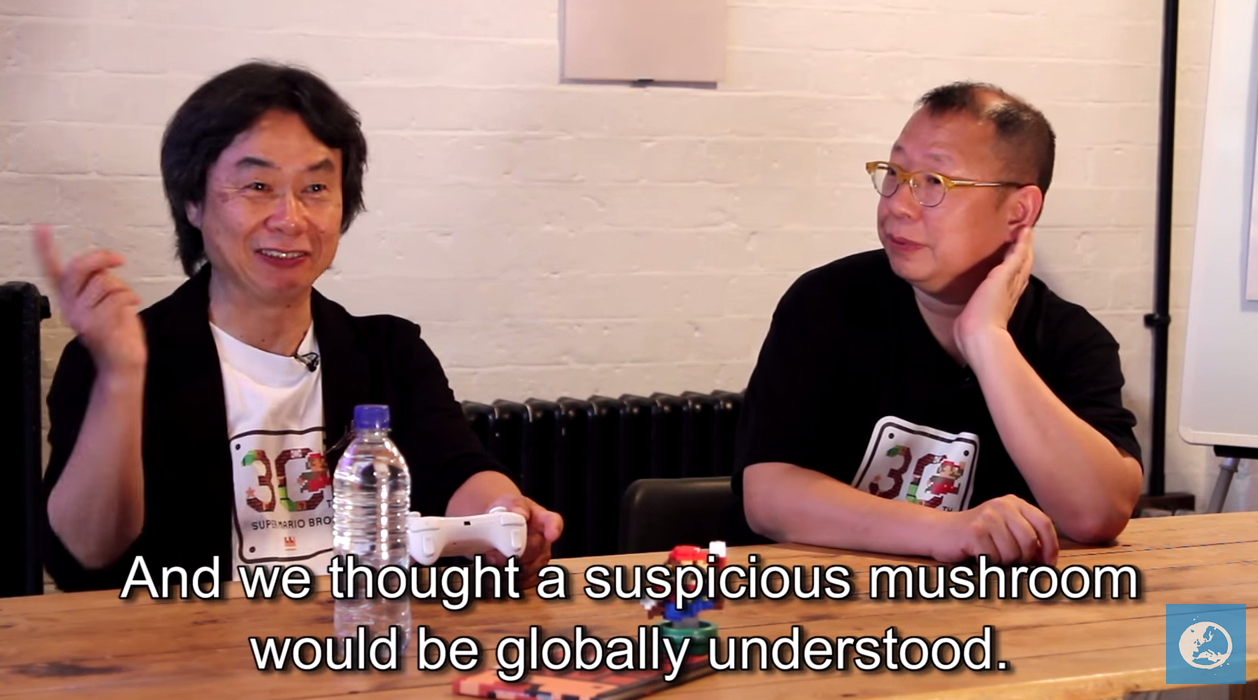
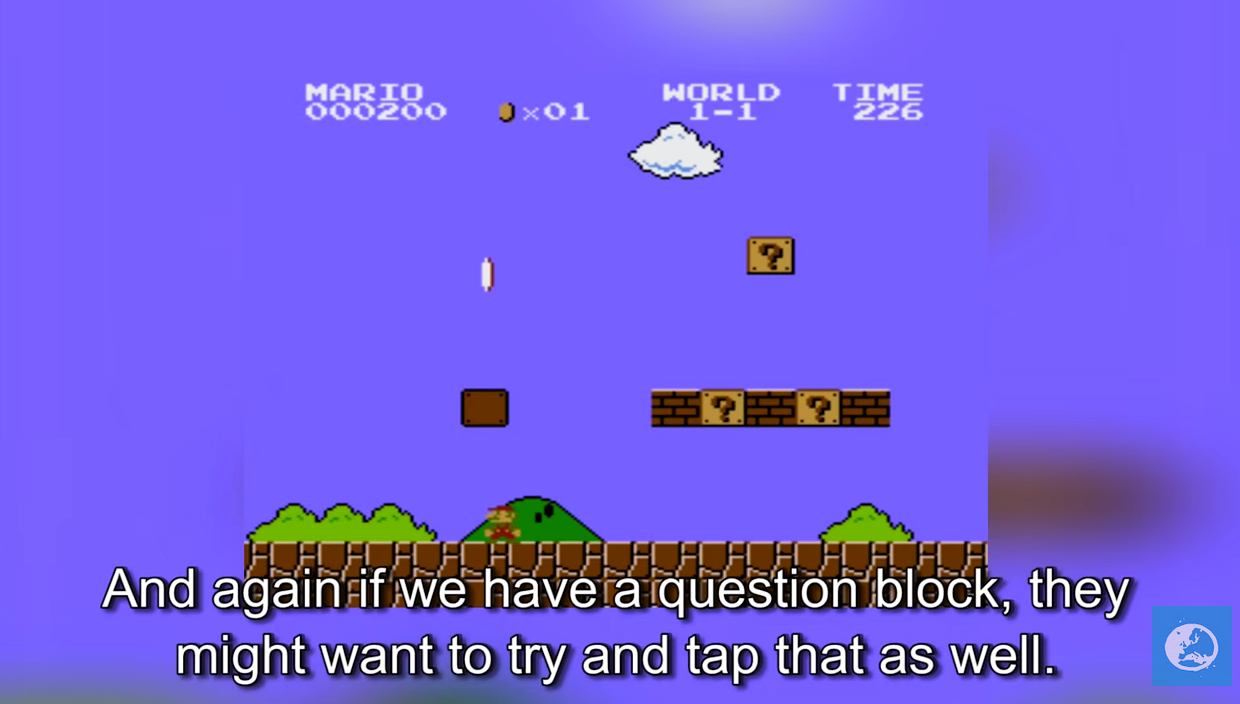
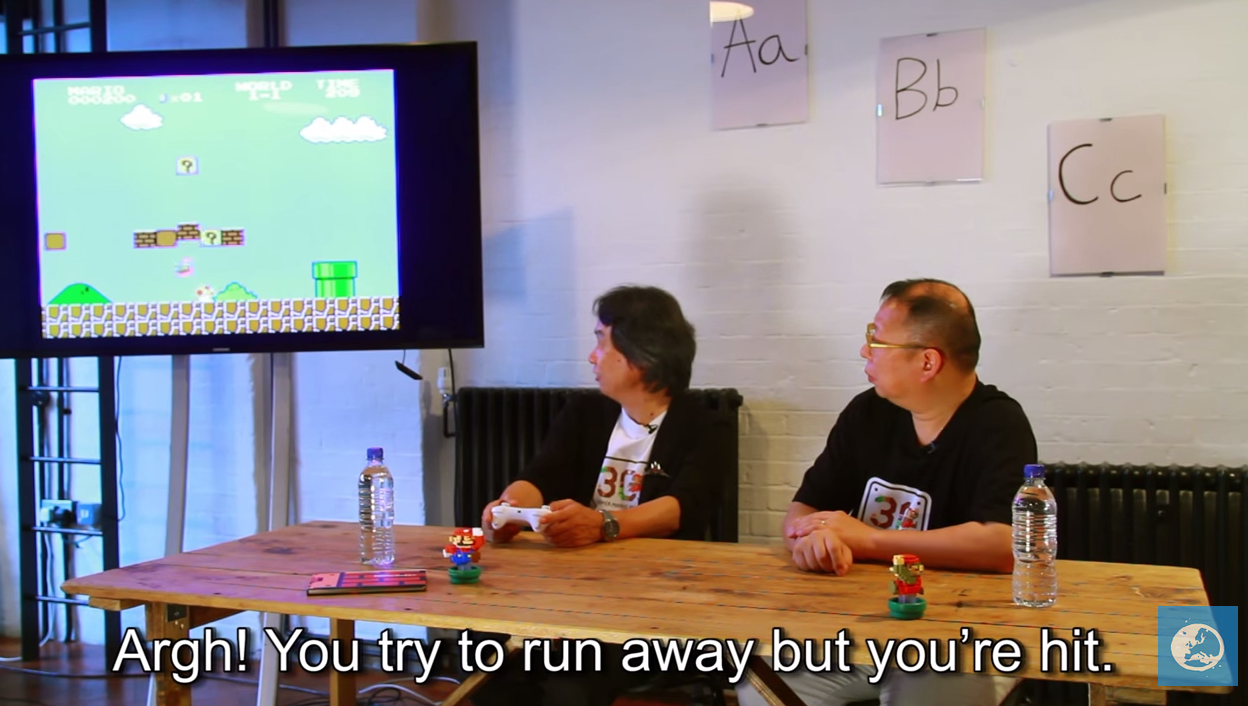
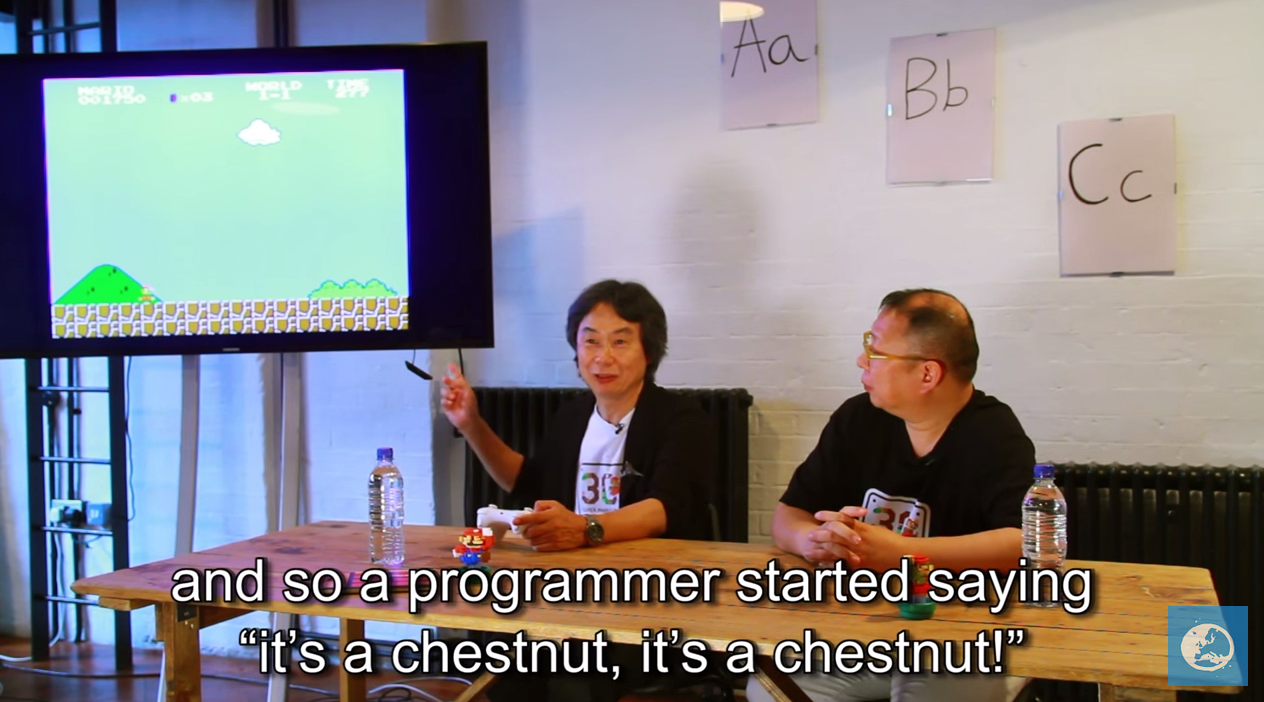
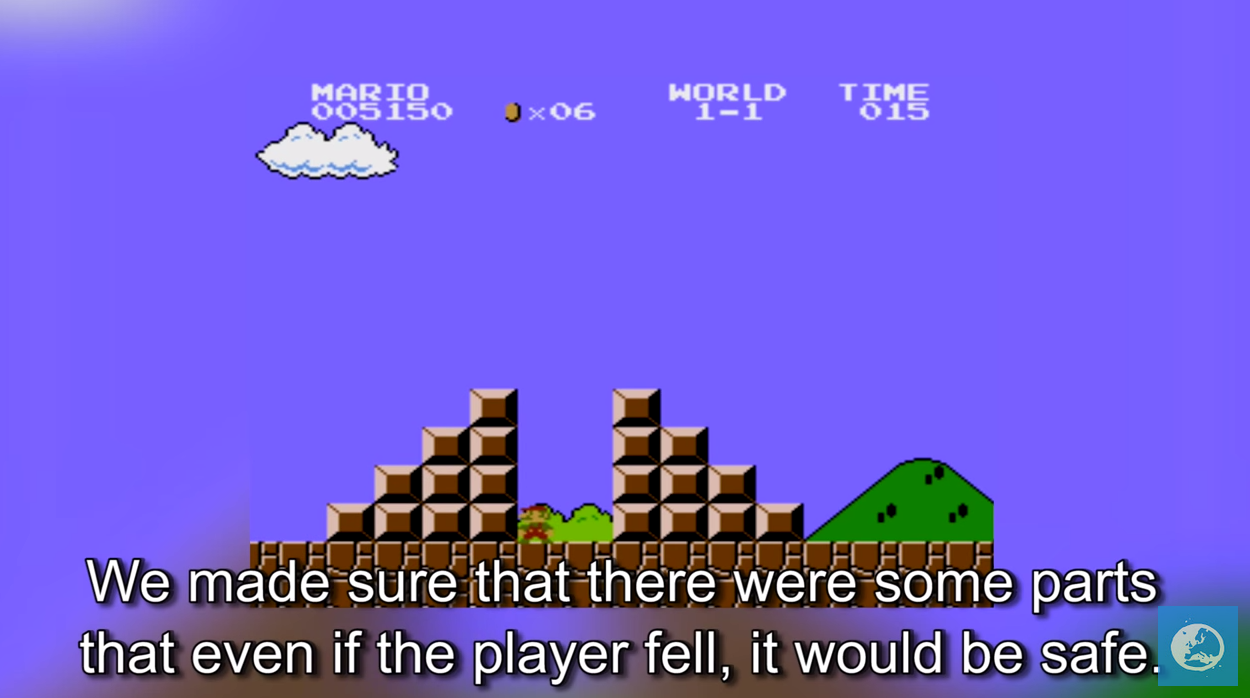
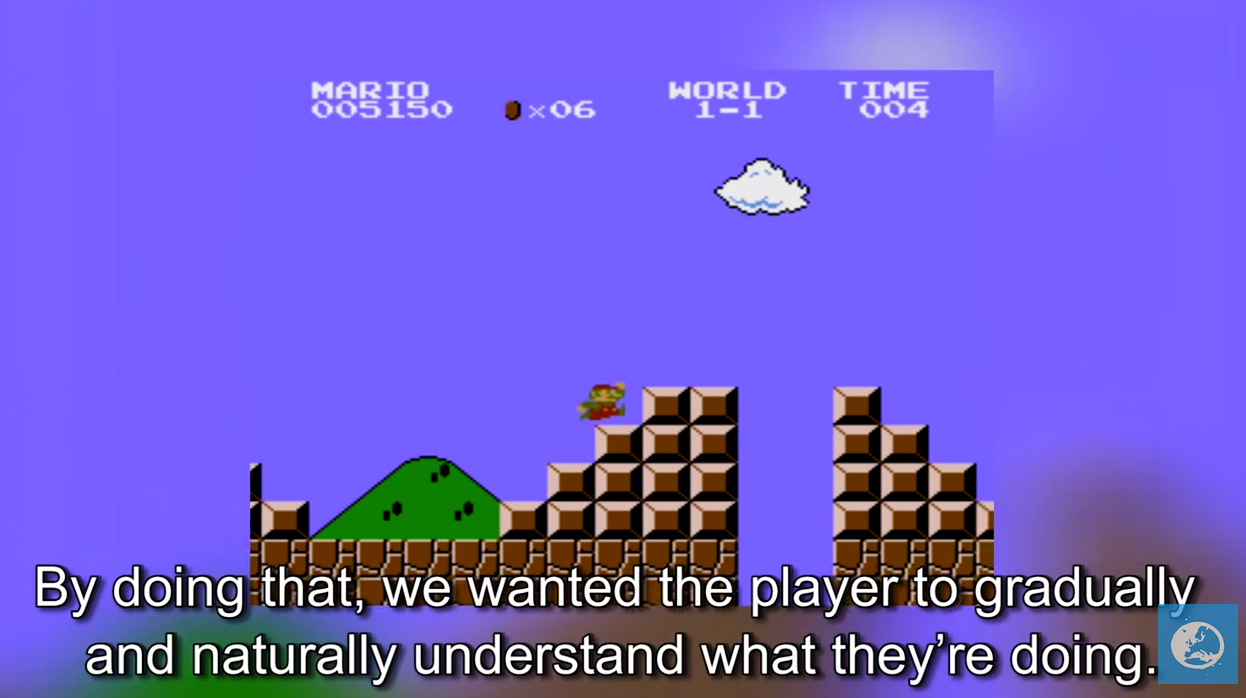
 The reason why Nintendo’s Super Mario smartphone game won’t have in-app purchases is brilliant
The reason why Nintendo’s Super Mario smartphone game won’t have in-app purchases is brilliant 8 things we learned from Nintendo’s Q&A video with Shigeru Miyamoto 【Video】
8 things we learned from Nintendo’s Q&A video with Shigeru Miyamoto 【Video】 Super Mario creator Shigeru Miyamoto performs Mario theme with hip hop’s The Roots 【Video】
Super Mario creator Shigeru Miyamoto performs Mario theme with hip hop’s The Roots 【Video】 The more you know Mario: The unusual Japanese names of Nintendo’s Super Mario characters
The more you know Mario: The unusual Japanese names of Nintendo’s Super Mario characters Super Mario Maker gets an official release date, will be playable at Best Buy soon【E3 2015】
Super Mario Maker gets an official release date, will be playable at Best Buy soon【E3 2015】 Disillusionment at Tsukiji’s tourist-target prices led us to a great ramen restaurant in Tokyo
Disillusionment at Tsukiji’s tourist-target prices led us to a great ramen restaurant in Tokyo More Than a Capsule Stay: Why Solo Travelers Choose “global cabin Yokohama Chinatown”
More Than a Capsule Stay: Why Solo Travelers Choose “global cabin Yokohama Chinatown” Haunted hospital near Mt Fuji re-opens after renovation at Fuji-Q Highland, and it’s terrifying
Haunted hospital near Mt Fuji re-opens after renovation at Fuji-Q Highland, and it’s terrifying A Japanese dating app matched our bachelorette with a Buddhist monk, and she learned some things
A Japanese dating app matched our bachelorette with a Buddhist monk, and she learned some things What can 3,000 yen get you at a Japanese hamburger chain? We find out
What can 3,000 yen get you at a Japanese hamburger chain? We find out We eat 13 of the most highly recommended sushi items at Sushiro and pick the best of the best
We eat 13 of the most highly recommended sushi items at Sushiro and pick the best of the best Japan’s best-amenity budget hotel chain gets extra-affordable with “Global Cabin” rooms
Japan’s best-amenity budget hotel chain gets extra-affordable with “Global Cabin” rooms A Gintama fan’s emotional 19-year journey to buy a proper Lake Toya bokuto wooden katana【Pics】
A Gintama fan’s emotional 19-year journey to buy a proper Lake Toya bokuto wooden katana【Pics】 Is this the most relaxing Starbucks in Japan?
Is this the most relaxing Starbucks in Japan? 7-Eleven Japan starts new temporary luggage storage service in over 300 branches
7-Eleven Japan starts new temporary luggage storage service in over 300 branches Starbucks teams up with 166-year-old Kyoto doll maker for Year of the Horse decorations【Photos】
Starbucks teams up with 166-year-old Kyoto doll maker for Year of the Horse decorations【Photos】 Tokyo’s Tsukiji sushi neighborhood asks tour groups to stay away for the rest of the month
Tokyo’s Tsukiji sushi neighborhood asks tour groups to stay away for the rest of the month Street Fighter Hadouken Churros to be launched and eaten in Tokyo, Okami pudding on offer too
Street Fighter Hadouken Churros to be launched and eaten in Tokyo, Okami pudding on offer too Japanese avoiding domestic travel as foreign tourists increase, possibly creating vicious cycle
Japanese avoiding domestic travel as foreign tourists increase, possibly creating vicious cycle Japanese woman mistaken for bear
Japanese woman mistaken for bear Return of Totoro sequel short anime announced for Ghibli Park
Return of Totoro sequel short anime announced for Ghibli Park Starbucks on a Shinkansen bullet train platform: 6 tips for using the automated store in Japan
Starbucks on a Shinkansen bullet train platform: 6 tips for using the automated store in Japan More Shinkansen trains being added to Japan’s “golden route” to meet traveler demand
More Shinkansen trains being added to Japan’s “golden route” to meet traveler demand Japan’s human washing machines will go on sale to general public, demos to be held in Tokyo
Japan’s human washing machines will go on sale to general public, demos to be held in Tokyo Starbucks Japan unveils new Christmas goods and a rhinestone tumbler that costs 19,500 yen
Starbucks Japan unveils new Christmas goods and a rhinestone tumbler that costs 19,500 yen Japanese train company is letting fans buy its actual ticket gates for their homes
Japanese train company is letting fans buy its actual ticket gates for their homes Is China’s don’t-go-to-Japan warning affecting tourist crowds in Tokyo’s Asakusa neighborhood?
Is China’s don’t-go-to-Japan warning affecting tourist crowds in Tokyo’s Asakusa neighborhood? The 10 best day trips from downtown Tokyo【Survey】
The 10 best day trips from downtown Tokyo【Survey】 Tokyo considering law requiring more trash cans following litter increase in heavily touristed area
Tokyo considering law requiring more trash cans following litter increase in heavily touristed area Nintendo’s Kirby now delivering orders at Kura Sushi restaurants, but not in Japan
Nintendo’s Kirby now delivering orders at Kura Sushi restaurants, but not in Japan Survey asks foreign tourists what bothered them in Japan, more than half gave same answer
Survey asks foreign tourists what bothered them in Japan, more than half gave same answer Japan’s deadliest food claims more victims, but why do people keep eating it for New Year’s?
Japan’s deadliest food claims more victims, but why do people keep eating it for New Year’s? We deeply regret going into this tunnel on our walk in the mountains of Japan
We deeply regret going into this tunnel on our walk in the mountains of Japan Studio Ghibli releases Kodama forest spirits from Princess Mononoke to light up your home
Studio Ghibli releases Kodama forest spirits from Princess Mononoke to light up your home Major Japanese hotel chain says reservations via overseas booking sites may not be valid
Major Japanese hotel chain says reservations via overseas booking sites may not be valid Put sesame oil in your coffee? Japanese maker says it’s the best way to start your day【Taste test】
Put sesame oil in your coffee? Japanese maker says it’s the best way to start your day【Taste test】 The top 10 annoying foreign tourist behaviors on trains, as chosen by Japanese people【Survey】
The top 10 annoying foreign tourist behaviors on trains, as chosen by Japanese people【Survey】 No more using real katana for tourism activities, Japan’s National Police Agency says
No more using real katana for tourism activities, Japan’s National Police Agency says Starbucks Japan reveals new sakura drinkware collection, inspired by evening cherry blossoms
Starbucks Japan reveals new sakura drinkware collection, inspired by evening cherry blossoms Hollywood producer talks about upcoming new Super Mario movie, doesn’t make it sound not terrible
Hollywood producer talks about upcoming new Super Mario movie, doesn’t make it sound not terrible Mario creator demonstrates Super Mario Run gameplay in new video
Mario creator demonstrates Super Mario Run gameplay in new video Dedicated fan recreates video play-through of Super Mario Bros… in Minecraft
Dedicated fan recreates video play-through of Super Mario Bros… in Minecraft The trailer for the Super Mario Bros. CG animated movie is finally here【Video】
The trailer for the Super Mario Bros. CG animated movie is finally here【Video】 Super Mario Bros. animated movie seemingly going deep in Nintendo lore with return of classic foe
Super Mario Bros. animated movie seemingly going deep in Nintendo lore with return of classic foe Super Mario movie delayed, Nintendo posts strange apology
Super Mario movie delayed, Nintendo posts strange apology Super Mario World 1-1 perfectly recreated, animation and all, in Japanese fan’s notebook【Vid】
Super Mario World 1-1 perfectly recreated, animation and all, in Japanese fan’s notebook【Vid】 30 things that come to mind replaying the original Super Mario Bros.
30 things that come to mind replaying the original Super Mario Bros. Real Buddhist monk plays Super Mario Bros., recites prayers every time he kills an enemy【Video】
Real Buddhist monk plays Super Mario Bros., recites prayers every time he kills an enemy【Video】 Nintendo is coming to iPhones with Super Mario Run for iOS devices
Nintendo is coming to iPhones with Super Mario Run for iOS devices Mario AND Luigi team up for new infinite lives trick in Super Mario Bros. 【Video】
Mario AND Luigi team up for new infinite lives trick in Super Mario Bros. 【Video】 Lush x Super Mario Bros. Movie collaboration is filled with surprises for Nintendo fans
Lush x Super Mario Bros. Movie collaboration is filled with surprises for Nintendo fans Have a Super Mario Summer with Nintendo’s newest line of outdoor leisure products
Have a Super Mario Summer with Nintendo’s newest line of outdoor leisure products Super Mario umbrellas let you recreate scenes from the Nintendo classic on rainy days【Photos】
Super Mario umbrellas let you recreate scenes from the Nintendo classic on rainy days【Photos】 Troll levels still abound in Mario Maker, Nintendo releases another sassy pigeon comic to help
Troll levels still abound in Mario Maker, Nintendo releases another sassy pigeon comic to help
Leave a Reply